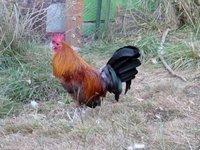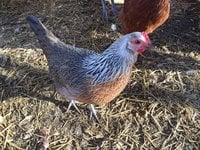General Information
- Breed Purpose
- Ornamental
- Broodiness
- Frequent
- Egg Productivity
- Medium
- Egg Size
- Small
- Egg Color
- White to Ivory
- Breed Size
- Bantam
- APA/ABA Class
- Game Bantam
Unlike many of the bantams you may see listed here, American Game Bantams (AGBs) are distinct from their namesake large fowl counterparts in that the bantams are an accepted breed by the major breed organizations while the large fowl counterparts are not. AGBs owe this to the work of Frank Gary of New Jersey, who worked with the ABA in the 1940s to develop a standard breed predominantly using bantam game birds (now referred to as either "pit bantams" or "mini-games") with Red Jungle Fowl bred in to improve hackle and saddle feather length and other show qualities. Thus the original variety of AGB was the Black Breasted Red (BBR). Unfortunately, it does not appear that the AGBs available today are descended from Frank Gary's lines.
Currently, there are 12 accepted varieties of AGBs, but two of these are only accepted by the ABA. Varieties currently accepted by the APA are Birchen, Black, BBR, Blue, Blue Red, Brown Red, Golden Duckwing, Red Pyle, Silver Duckwing, and White. Brassy Back and Wheaten are listed in the ABA only, although Quail was apparently accepted at one time, but no one seems to know how it was replaced by Brassy Back.
My experience has been that these are very vigorous birds, forage well, and are good fliers. AGB hens tend to be much better layers than other game bantams, which is partly attributable to their greater weight compared to Old English Game Bantams (OEGBs) and Modern Game Bantams (MGBs). AGB cocks average 30 ounces and hens at 27 ounces and should have a more substantial feel to them. As with OEGBs and MGBs, they are required to be dubbed for show, but in manner similar to OEGBs (high dub) rather than MGBs.
Males should be well feathered with long, wiry hackle and saddle feathers that spill out over the shoulders and back and should have a tail held at a 50 degree angle with long sickle feathers that form a semi-cardioid (half heart) shape - a defining characteristic of the breed! Tails should be well spread on females. Feathering should be hard in the manner of game fowl. The birds should have a graceful, upright stance and carry themselves with pride so they have, as close as possible, the shape and carriage of large fowl American Games (scaled down, of course).
As many lines of AGBs have recent infusions of large fowl games, they are very aggressive towards other AGBs and other game breeds (but not humans), but can generally be kept in communal grow-out pens until six months. After that, males must be kept separate. Females can also be aggressive among themselves and may even have tiny spurs, but will generally accept other pullets/hens after they "work things out". They can go broody easily, but my experience is that they tend to want to stay on unhatched eggs rather take care of the chicks they've hatched.
AGBs are listed as "Not Common" in the ABA standard, but I have trouble understanding why. They are everything you'd want in a bantam and then some: active, brave, disease resistant, good layers, graceful and beautiful. Consider keeping a trio.
Currently, there are 12 accepted varieties of AGBs, but two of these are only accepted by the ABA. Varieties currently accepted by the APA are Birchen, Black, BBR, Blue, Blue Red, Brown Red, Golden Duckwing, Red Pyle, Silver Duckwing, and White. Brassy Back and Wheaten are listed in the ABA only, although Quail was apparently accepted at one time, but no one seems to know how it was replaced by Brassy Back.
My experience has been that these are very vigorous birds, forage well, and are good fliers. AGB hens tend to be much better layers than other game bantams, which is partly attributable to their greater weight compared to Old English Game Bantams (OEGBs) and Modern Game Bantams (MGBs). AGB cocks average 30 ounces and hens at 27 ounces and should have a more substantial feel to them. As with OEGBs and MGBs, they are required to be dubbed for show, but in manner similar to OEGBs (high dub) rather than MGBs.
Males should be well feathered with long, wiry hackle and saddle feathers that spill out over the shoulders and back and should have a tail held at a 50 degree angle with long sickle feathers that form a semi-cardioid (half heart) shape - a defining characteristic of the breed! Tails should be well spread on females. Feathering should be hard in the manner of game fowl. The birds should have a graceful, upright stance and carry themselves with pride so they have, as close as possible, the shape and carriage of large fowl American Games (scaled down, of course).
As many lines of AGBs have recent infusions of large fowl games, they are very aggressive towards other AGBs and other game breeds (but not humans), but can generally be kept in communal grow-out pens until six months. After that, males must be kept separate. Females can also be aggressive among themselves and may even have tiny spurs, but will generally accept other pullets/hens after they "work things out". They can go broody easily, but my experience is that they tend to want to stay on unhatched eggs rather take care of the chicks they've hatched.
AGBs are listed as "Not Common" in the ABA standard, but I have trouble understanding why. They are everything you'd want in a bantam and then some: active, brave, disease resistant, good layers, graceful and beautiful. Consider keeping a trio.


